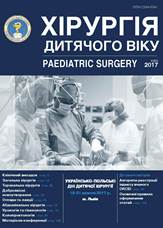Sharp fixed foreign objects of trachea or bronchus in children
DOI:
https://doi.org/10.15574/PS.2017.57.20Keywords:
acute fixed foreign objects, diagnosis, endoscopic examination, treatment, childrenAbstract
Objective. To generalize the experience and improve the specialized endoscopic assistance in children with acute fixed foreign objects in trachea or bronchi.Material and methods. The work is based on the results of endoscopic examination and instrumental removal of fixed sharp foreign objects from the respiratory tract in 58 patients over the last 20 years. The interpretation of discovered during endoscopic examination pathological changes was performed according to generally accepted criteria. Timely diagnosis and urgent endoscopic intervention has provided positive treatment results in all clinical cases, although we observed complications from the long-term stay of a foreign body in the respiratory tract, namely: pneumonia in 8, destructive pneumonia in 2, atelectasis in 9, bronchiectasis in 3, deforming bronchitis in 11 patients. Life-threatening complications related to the endoscopic examination and instrumental removal of fixed sharp foreign bodies from the respiratory tract were not observed.
Results. The treatment outcomes depended upon the timely admission of child to the surgical hospital, urgent endoscopic examination and instrumental removal. Treatment of posttraumatic changes and complications in the trachea or bronchi was based on the data of the dynamic endoscopic examination. A prerequisite of adequate treatment was the presence of qualified medical staff and modern technical equipment.
Conclusions. Diagnostic endoscopic examination of the respiratory tract was conducted for all children before deleting a fixed sharp foreign object, after its removal and in the dynamics of treatment after traumatic changes. The main conditions for effective removal of the foreign object were visual orientation and technical components, which allowed minimizing the injury rate of the main stage, its instrumental removal. All children received comprehensive medical treatment, which included a dynamic endoscopic examination: two diagnostic and therapeutic fibro-, tracheobronchoscopy were made in 24 cases, three – in 11, four – in 8, five – 4, and six procedures – in 3 patients. Long-term results were studied in all cases.
Downloads
Issue
Section
License
The policy of the Journal “PAEDIATRIC SURGERY. UKRAINE” is compatible with the vast majority of funders' of open access and self-archiving policies. The journal provides immediate open access route being convinced that everyone – not only scientists - can benefit from research results, and publishes articles exclusively under open access distribution, with a Creative Commons Attribution-Noncommercial 4.0 international license(СС BY-NC).
Authors transfer the copyright to the Journal “PAEDIATRIC SURGERY.UKRAINE” when the manuscript is accepted for publication. Authors declare that this manuscript has not been published nor is under simultaneous consideration for publication elsewhere. After publication, the articles become freely available on-line to the public.
Readers have the right to use, distribute, and reproduce articles in any medium, provided the articles and the journal are properly cited.
The use of published materials for commercial purposes is strongly prohibited.

